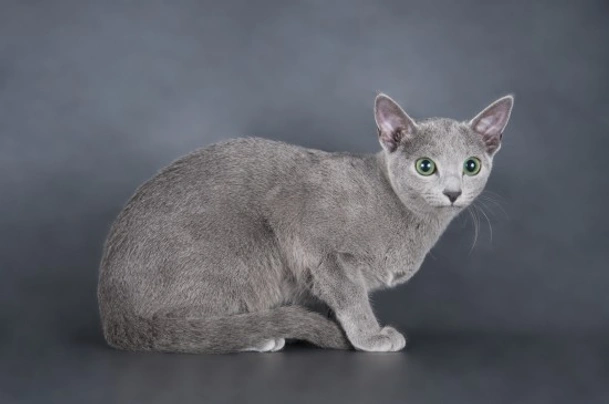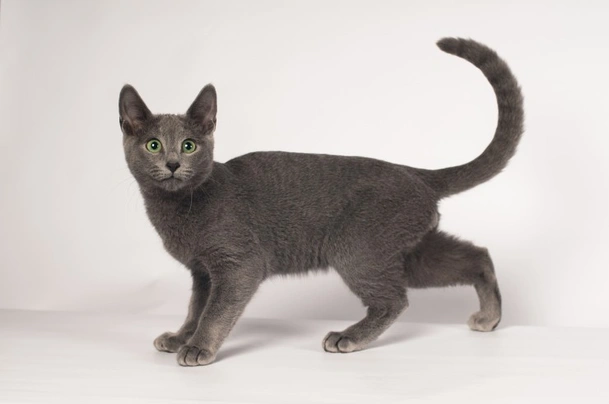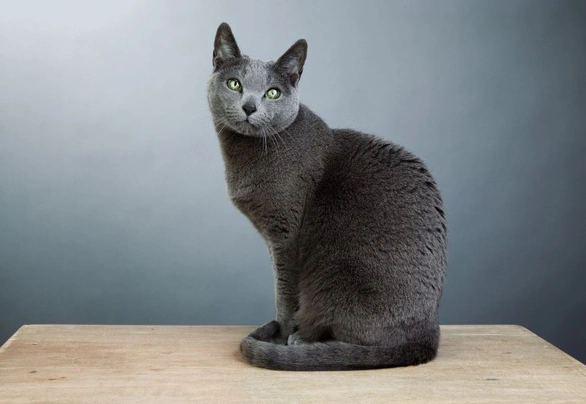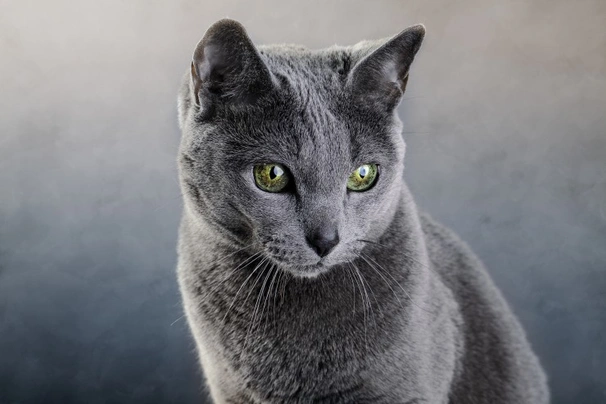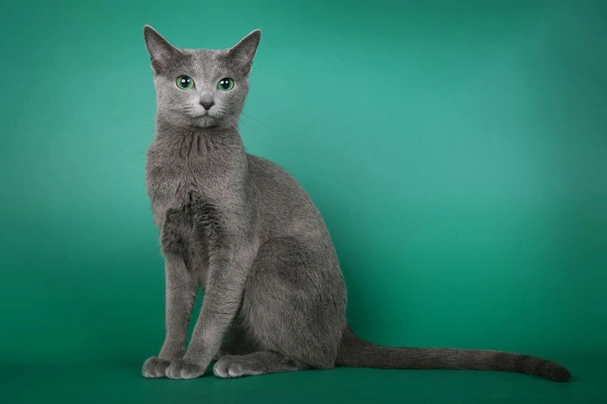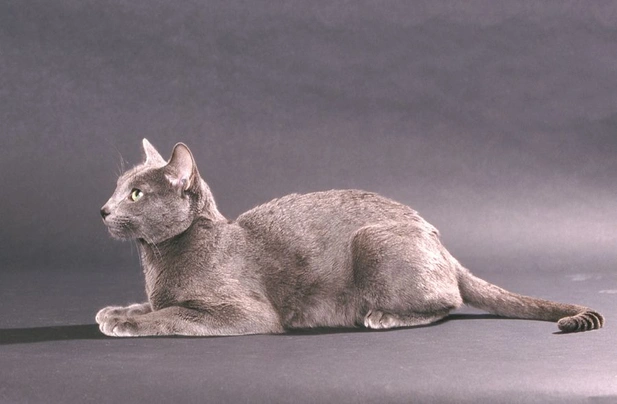Russian Blue
Introduction of the Russian Blue
The Russian is the aristocrat of the feline world with their shimmering coats and graceful elegant looks. They boast having incredible emerald green eyes which contrast supremely well with a cat's coat colour. Russians also have very endearing smiles on their faces which is another reason why these medium size cats have found their way into the hearts and homes of people throughout the world and they have done so for decades. Russians are also well known for being highly intelligent and for the fact they thrive in a home environment forming strong bonds with their owners and families which makes them such wonderful companions and family pets.
History of the Russian Blue
The Russian first appeared on the scene in Arkhangelsk a Russian port that’s situated on the White Sea. They are often called Archangel cats for this very reason. Sailors took their cats with them on their voyages which is how the Russian arrived in other European countries which includes Britain during the early 1860's. There are very similar looking cats that can still be seen in Russia's colder regions where they have always been thought of as bringing luck to whoever owns one.
Engravings and pictures of "blue" cats have been found in Russia which were given to brides on their wedding days. The breed is even mentioned in a book by Harrison Weir who is the founder of the British Cat Fancy which was published in 1893. However in 1917 right up to 1948 the breed was known as the Foreign Blue after which time the breed was given the name Russian Blue.
The modern Russian boasts an interesting lineage with British Blues and Blue Point Siamese being in their pedigree. They were outcrossed to various breeds as a way of saving them from extinction during the 1950s when their numbers were seen to fall dangerously low. However today the Siamese traits have been bred out of Russians and it is considered bad for them to be outcrossed to other breeds thanks to the fact their breed numbers have risen and as such the gene pool is healthy.
The first Russians arrived on British shores in the 1880s when they were exhibited at the very first cat shows to be held at Crystal Palace. They were an immediate hit with breeders and the public alike thanks to their charming looks their gorgeous coats and their kind affectionate natures. Today Russians remain a popular choice both as companions and family pets for these very reasons.
Appearance of the Russian Blue
The Russian boasts having a dense short and very luxurious coat which is the breed's hallmark. They are extremely graceful medium to large size cats that have muscular lithe bodies and elegant long finely boned legs with males being typically heavier and larger than their female counterparts. Their heads are wedge-shaped and Russians always seem to have a smile on their faces which is another of the breed's distinguishing and endearing physical traits. They have wide cheekbones which are set nice and high. Their eyes are emerald green and large being almost almond-shaped. Ears are large and flared being wider at the base so they frame a cat's face adding to the Russian's foreign looks.
The top of a cat's head appears flat between their ears and muzzles are broad with well-defined and prominent whisker pads. Seen in profile a cat's forehead looks level with the upper part of their eye creating a distinctive angle. There is no stop nose bump or break and their chins are nicely in line with the tip of the nose. Chins are deep and strong with cats having a nice level bite.
The Russian has a medium to large size body that boasts having a very graceful outline. They have long elegant legs and small oval paws. Their tails are moderately long being nicely in proportion with a cat's body. They are lithe athletic and well-balanced cats that move extremely gracefully.
When it comes to their coat the Russian boasts having a double coat with a thick dense very soft undercoat that stands well away from their body. They come in three colours which are as follows:
- Russian Blue
- Russian Black
- Russian White
Temperament of the Russian Blue
Like a lot of other breeds the Russian likes a routine and doesn't particularly like it when this changes for any reason. They like to be fed at the same time of the day and don't appreciate it when any furniture gets moved around the home. With this said Russians are known to be gentle by nature and boasts having a "quiet" voice except when a female is in season that is which is when they can be extremely vocal much like other breeds.
They are known to be extremely affectionate without being overly demanding which has seen the breed become a popular companion for elderly people. They are also known to be tolerant by nature which in short means they are also good around children and don't get too upset when a younger child plays with them a little roughly. Russians will wriggle their way of a child's grasp rather than use their claws to get away.
Russians like other breeds enjoy spending time in the great outdoors however cats should only be allowed outside if it is safe for them to do so. The good news is that Russians adapt well to living as indoor pets as long as they are given enough mental stimulation to keep their minds occupied when they are not cat napping that is. They are ideally suited to households where at least one person stays at home when everyone else is out of the house or where there are other family pets.
They tend to be a little reserved around people they don't already know preferring to observe them first which often means that people think Russians are aloof and reserved. However once a cat decides a person is worthy of their attention they go right up to them to say “hello”. They adore being petted and given as much attention as they can get when their owners are around. It is quite natural for a Russian to sit on a computer keyboard when their owners are trying to type just to get their attention. With this said they are not clingy by nature and are quite happy to be left on their own as long as it is not for an extended period of time.
Intelligence / Trainability of the Russian Blue
The Russian is a smart cat and one that likes to learn new things. They also enjoy playing interactive games with their owners although they do take their time to decide whether a game is worth playing or not. With this said the Russian is very adept at learning how to open cupboards especially if there are any treats or food in them and they take great pleasure in showing off their skills.
Children and other
Russians with their laid-back affectionate personalities are a good choice for families with children. However care has to be taken when very young children are around cats and any interaction should always be supervised by an adult to make sure things stay nice and calm. With this said younger children need to be taught how to behave around cats and when it's time to leave them alone.
They also get on well with dogs especially if they have grown up together in the same household. However care has to be taken when introducing a Russian to dogs they don't already know just in case the dog does not get on with their feline counterparts. Russians are incredibly social by nature and have been known to get on with small animals. However it's always wiser to keep a close eye on any cat when they are around smaller pets just in case a cat's prey drive gets the better of them.
Health of the Russian Blue
The average life expectancy of a Russian is between 15 and 20 years when properly cared for and fed an appropriate good quality diet to suit their ages.
The Russian is known to be one of the healthiest breeds around and are not generally known to suffer from any hereditary or genetic disorders unlike many other pedigree cats.
Caring for the Russian Blue
As with any other breed Russians need to be groomed on a regular basis to make sure their coats and skin are kept in top condition. On top of this cats need to be fed good quality food that meets all their nutritional needs throughout their lives which is especially true of kittens and older cats.
Grooming of the Russian Blue
Russians boast having short close lying dense coats which means they are low maintenance on the grooming front. A weekly brush and wipe over with a chamois leather is all it takes to keep their coats in good condition with a nice sheen on it. Like other cats they tend to shed the most in the Spring and then again in the Autumn when more frequent brushing is usually necessary to keep on top of things.
It's also important to check a cat's ears on a regular basis and to clean them when necessary. If too much wax is allowed to build up it can lead to a painful infection which can be hard to clear up. In short prevention is often easier than cure with ear infections. Cats often suffer from ear mites which can be a real problem which is why it's so important to check their ears on a regular basis.
Exercise of the Russian Blue
The Russian is an energetic intelligent cat and one that adores learning new things. They enjoy playing interactive games and are extremely adept when it comes to retrieving toys. They like to climb up high so they can look down on the world below. In short Russians love a high vantage point so they can contemplate and observe everything that goes on in their environment and decide whether it’s worth joining in.
Cats kept as indoor pets need to be given lots of things to do and places to hide when they want to. They also need to have lots of places they can snuggle up for a snooze when the mood takes them because like other breeds the Russian loves to snooze the day away in a favourite warm and sunny spot. It's worth noting that they are also very capable of fitting into the smallest of spaces which often takes their owners a little by surprise.
Feeding of the Russian Blue
If you get a Russian kitten from a breeder they would give you a feeding schedule and it's important to stick to the same routine feeding the same kitten food to avoid any tummy upsets. You can change a kitten's diet but this needs to be done very gradually always making sure they don't develop any digestive upsets and if they do it's best to put them back on their original diet and to discuss things with the vet before attempting to change it again.
Older cats are not known to be fussy eaters but this does not mean they can be given a lower quality diet. It's best to feed a mature cat several times a day making sure it's good quality food that meets all their nutritional requirements which is especially important as cats get older. It's also essential to keep an eye on a cat's weight because if they start to put on too much it can have a serious impact on their overall health and wellbeing. Like all other breeds Russians need access to fresh clean water at all times.
Russian Blue price
If you are looking to buy a Russian you would need to pay anything from £350 to over £800 for a well-bred pedigree kitten. The cost of insuring a male 3-year-old Russian in northern England would be £13.13 a month for basic cover but for a lifetime policy this would set you back £25.29 a month (quote as of October 2016). When insurance companies calculate a pet's premium they factor in several things which includes where you live in the UK a cat's age and whether or not they have been neutered or spayed among other things.
When it comes to food costs you need to buy the best quality food whether wet or dry making sure it suits the different stages of a cat’s life. This would set you back between £15 - £20 a month. On top of all of this you need to factor in veterinary costs if you want to share your home with a Russian and this includes their initial vaccinations their annual boosters the cost of neutering or spaying a cat when the time is right and their yearly health checks all of which quickly adds up to over £500 a year.
As a rough guide the average cost to keep and care for a Russian would be between £40 to £60 a month depending on the level of insurance cover you opt to buy for your cat but this does not include the initial cost of buying a well-bred kitten.

Mix Russian Blue and Maine Coon
£300
(TOP QUALITY) TICA REGISTERED RUSSIAN BLUE KITTENS
£1,350
